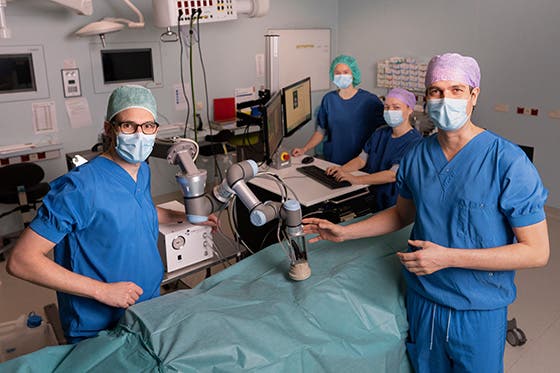Treating artery stenosis with sound waves

By aiming high-frequency sound waves at a narrowing – a plaque – in the artery, it is broken down layer by layer. That is the theory behind the Hifu treatment (High Intensity Focused Ultrasound). This method has recently been successfully tested in patients with artery stenosis in the groin. This non-invasive operation can be an alternative to patients in the long term to surgery or stent placement.
UMC Utrecht vascular surgeon Stijn Hazenberg: “The Hifu technique has originated in oncology, in which the UMC Utrecht was even declared a center of excellence on January 18. We are now the first hospital to use this technique for artery stenosis. This is still experimental, but the results of the first patients treated are encouraging. We hope to complete this safety study within a year. The more extensive clinical trial, which will follow, will take several years to complete.”
The Hifu technique has originated in oncology. The UMC Utrecht was even declared a center of excellence in this field on January 18, 2021 and is the first to use this – as yet experimental– technique for artery stenosis. According to vascular surgeon Hazenberg, innovations in the treatment of peripheral artery disease are badly needed in order to make the interventions even less invasive and more efficient. Hazenberg: “There are many hospital and day treatment admissions in the Netherlands for patients with peripheral artery disease (in 2019 2998 and 1677 respectively). This number is expected to increase further in the coming years, due in part to the increase in the number of diabetics.”
Intermittent claudication
Narrowing of the arteries in the legs is called peripheral artery disease, but it is also known intermittent claudication. People have much more difficulty walking, for example. “In many places in the body, we treat arterial plaque by angioplasty, possibly in combination with the insertion of a stent,” explains Hazenberg. “With peripheral arterial disease in places like the groin, that doesn’t work. This still requires invasive (open) surgery. We clamp the arteries, open them, remove the plaque and close them. Besides being a major operation, there are also risks involved. Around fifteen percent of people get an infection afterwards. Those infections vary in severity, but can have serious consequences up to and including amputation and even death.”
Hifu: heat by sound waves
In a Hifu treatment, high-frequency sound waves are directed at a narrowing in the artery (a plaque), breaking it down layer by layer. An ultrasound head is used to visualize the plaque, while the sound waves are simultaneously directed in such a way that they converge in the plaque. The resulting heat breaks down the cell structures of the plaque, after which the physical mechanism kicks in whereby the white blood cells, among others, clean up the broken cells. In this way, the plaque is damaged point by point and cleared up by the body’s own immune system.
Course of investigation
Hifu treatment has been shown to be safe in an animal study, and now the first-in-human phase is underway. “At the moment we are conducting the safety study in a small group of patients,” says Stijn. “We first need to be sure that the treatment is safe. The safety study is followed by an efficacy study, with the aim of scientifically demonstrating that the treatment actually works. We have now successfully treated five people in this way.” If Hifu treatment in the groin is finally scientifically proven to be effective, the treatment of artery stenosis in other parts of the body will be the next step.
Initial patient experiences
78-year-old Anton Spel is one of those five patients. “Walking was becoming increasingly painful. At one point I couldn’t walk more than 400 yards. I turned out to have a clogged blood vessel in my groin. When the doctor asked me if I wanted to participate in the study for a new treatment, I agreed. I didn’t notice anything of the treatment itself. Afterwards I had to stay in hospital for a few hours so they could check that everything was okay.”
Soon after the treatment, Anton noticed that he walked better. “With surgery it would have taken much longer to recover. Besides, surgery is not without risk.” The pain is not yet completely gone. “I keep a little nagging pain, but walking goes much better. Especially if I take it easy, I can walk a fair bit.”
